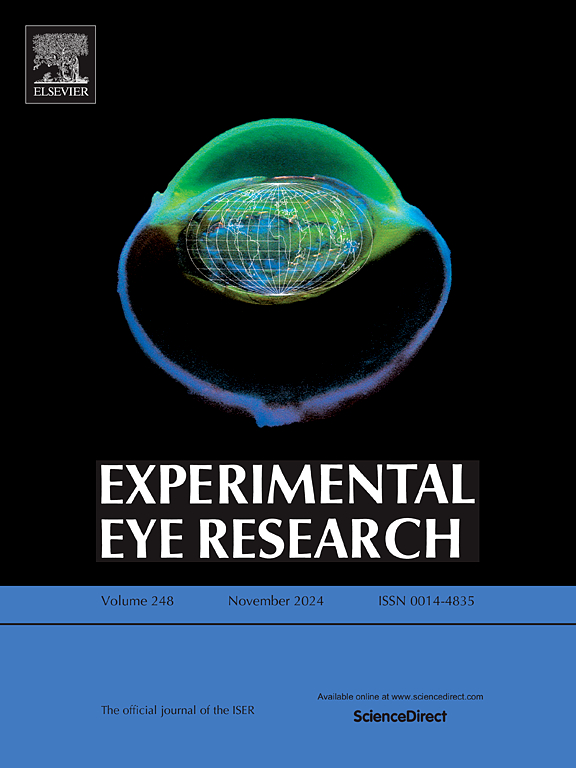Targeting pericytes in the retina: characterization of the inducible NG2-CreERT2 knock-in mouse model
IF 3
2区 医学
Q1 OPHTHALMOLOGY
引用次数: 0
Abstract
Pericytes (PCs) are mural cells embedded in a common basement membrane with endothelial cells (ECs) on capillaries. They are key players in the regulation of stability and function of blood vessels and are an essential component of the blood-brain and blood-retinal barrier. In addition, PCs are reported to be involved in wound healing and tissue regeneration and represent a promising target for the modulation of scarring processes. Due to their heterogeneous expression pattern, a single specific molecular marker for PCs remains elusive. Inducible reporter mouse models represent a frequently used tool for tracing the fate of a specific cell type, via the expression of a fluorescence reporter protein in the target cell following tamoxifen (TAM) induction. In a recent study, we characterized the TAM-inducible reporter mouse model NG2-CreERTM-tdTomato and demonstrated specific but marginal PC labeling in the retinal capillary plexuses with mean values ranging from 21.9 to 35.5 %. Since such a low labeling efficiency is not sufficient for reliable cell tracing, we characterized a TAM-inducible Cre mouse model expressing the enhanced estrogen receptor ERT2 in the present work. The NG2-CreERT2 knock-in mouse was crossbred with the tdTomato Ai9 reporter mouse to assess efficiency of PC labeling in the retina. The expression of tdTomato was restricted to mural cells, labeling vascular smooth muscle cells on larger vessels and PCs on capillaries. The use of the CreERT2 mouse resulted in an increased percentage of labeled PCs in the superficial layer of the retina with mean values ranging from 68.5 to 70.2 %.
靶向视网膜周细胞:诱导型NG2-CreERT2敲入小鼠模型的表征。
周细胞(PCs)是嵌在毛细血管上的内皮细胞(ECs)共同基底膜上的壁细胞。它们是调节血管稳定性和功能的关键角色,是血脑和血视网膜屏障的重要组成部分。此外,据报道,PCs参与伤口愈合和组织再生,并代表了疤痕过程调节的一个有希望的目标。由于它们的异质表达模式,单一的特异性分子标记仍然难以捉摸。诱导报告小鼠模型是一种常用的工具,用于追踪特定细胞类型的命运,通过在他莫昔芬(TAM)诱导后靶细胞中荧光报告蛋白的表达。在最近的一项研究中,我们对tam诱导的报告小鼠模型NG2-CreERTM-tdTomato进行了表征,并在视网膜毛细血管丛中发现了特异性但边缘性的PC标记,其平均值为21.9%至35.5%。由于如此低的标记效率不足以实现可靠的细胞追踪,我们在本工作中表征了tam诱导的表达增强雌激素受体ERT2的Cre小鼠模型。将NG2-CreERT2敲入小鼠与tdTomato Ai9报告小鼠杂交,以评估视网膜中PC标记的效率。tdTomato的表达仅限于壁细胞,标记大血管上的血管平滑肌细胞和毛细血管上的PCs。使用CreERT2小鼠导致视网膜浅层标记pc的百分比增加,平均值为68.5%至70.2%。
本文章由计算机程序翻译,如有差异,请以英文原文为准。
求助全文
约1分钟内获得全文
求助全文
来源期刊

Experimental eye research
医学-眼科学
CiteScore
6.80
自引率
5.90%
发文量
323
审稿时长
66 days
期刊介绍:
The primary goal of Experimental Eye Research is to publish original research papers on all aspects of experimental biology of the eye and ocular tissues that seek to define the mechanisms of normal function and/or disease. Studies of ocular tissues that encompass the disciplines of cell biology, developmental biology, genetics, molecular biology, physiology, biochemistry, biophysics, immunology or microbiology are most welcomed. Manuscripts that are purely clinical or in a surgical area of ophthalmology are not appropriate for submission to Experimental Eye Research and if received will be returned without review.
 求助内容:
求助内容: 应助结果提醒方式:
应助结果提醒方式:


